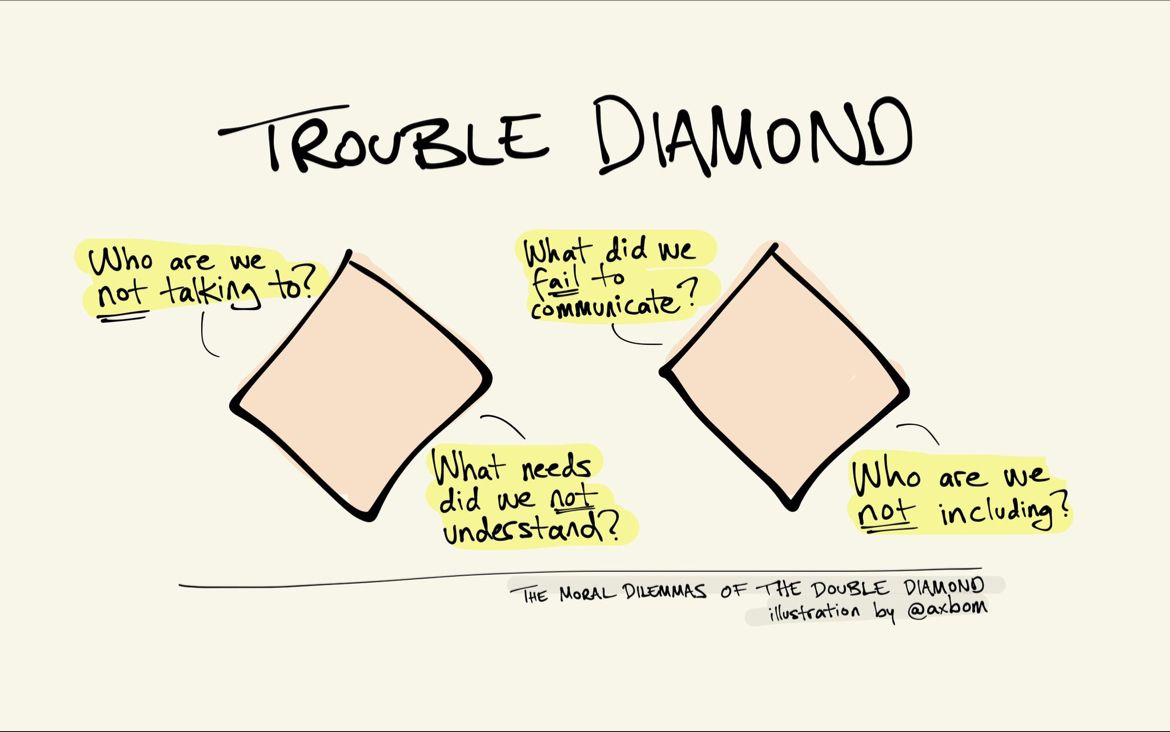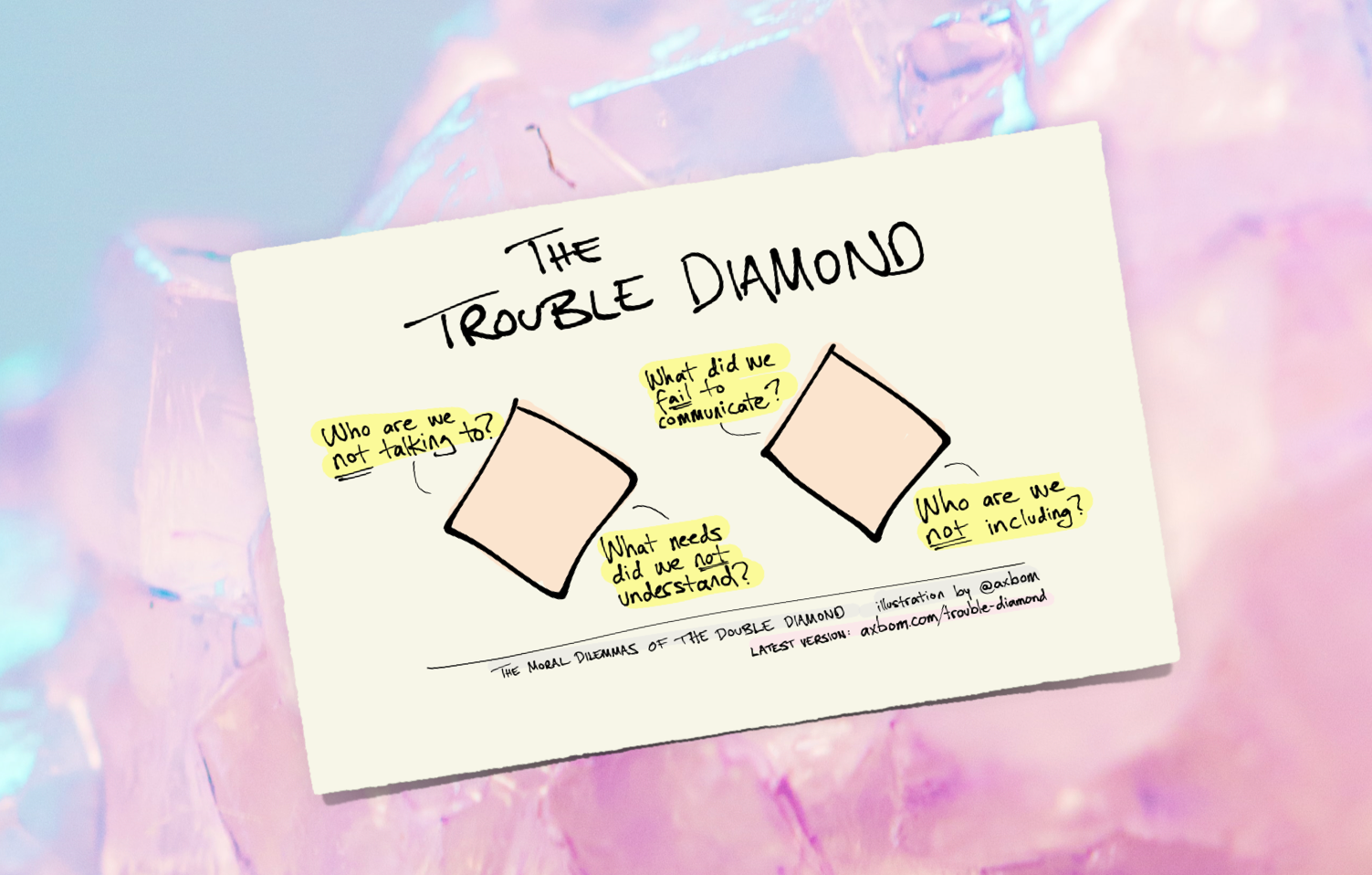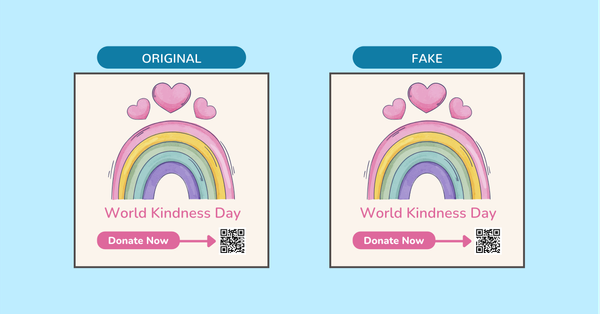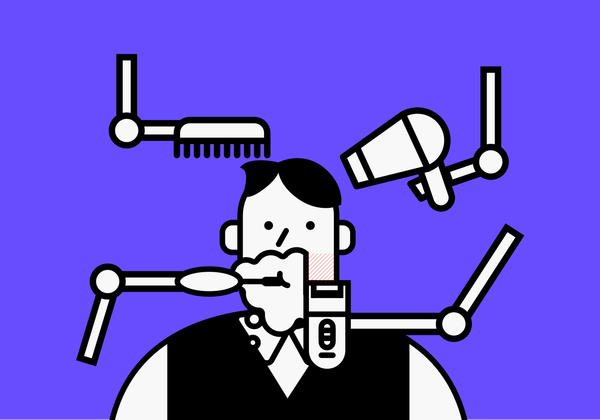I often strive to highlight how the common tools we use in human-centered design lead us astray and can actually contribute to exacerbating harmful design. One of those tools is The Double Diamond. And while I often propose new tools, one way of addressing harm is to identify the weaknesses in current tools and ensure we use them in a better way.
The first person in my network to point out obvious Double Diamond weaknesses was Alastair Somerville. See the further reading section at the end for articles and links related to these dilemmas.
Addressing double diamond weaknesses
A big part of design ethics is to engage in identifying possible outcomes of our actions that can be harmful to select people, or planet. The earlier we can do this, the better. And it's also something that can never stop.
By making ethics assessment a natural, integrated part of the Double Diamond, a persistent tool that is taught and lauded throughout the design industry and beyond, more makers can become better benevolent decision-makers.
I drew this sketch this morning over breakfast, so it must be regarded as a first draft. I hope with feedback I can finalize it into something useful. But perhaps the simplicity of the current version can be powerful as well:

The idea of The Trouble Diamond is to actively spend time with important questions related to the different stages of design. A big part of this is also being open and honest inside and outside teams, with clients and stakeholders. Design has never been and never will be the act of following a checklist or pre-defined process.
It serves no one well to promote the idea that enough research has been done, that everything from that research has been understood, that there are no communication issues when building new stuff and that we are not actively excluding people when design choices are made.
The more open and honest we can be about the fragile nature of design, the better we will become at mitigating harm.
The four questions in The Trouble Diamond are examples of what should be asked at different stages, or in different contexts. There is an answer to each question that highlights circumstances that can lead to harm. This means that we can do our best to also address these circumstances.
We must still acknowledge that we can not solve everything with design. This also underscores the importance of documenting those weaknesses that we were never able to address. Importantly, the questions in The Trouble Diamond should be documented as part of product delivery, with the intent to guide focus and prioritisation in future development, research and decision-making.
The 4 questions in The Trouble Diamond
There is one question for each of the stages in the traditional double diamond of design.
Discovery question: Who are we not talking to?
Who we interview, observe, pose questions to and decide to listen to varies with project intent, time and budget. When deciding to talk to someone we are always deciding that there is someone else we do not talk to, consciously or not.
Understanding that there are many unheard voices affected by our work is key to assessing the value of the research. It may also lead to realising that many further exploratory measures are required.
Decisions about who to include in research can also steer future decision-making completely wrong, if we are too late in recognising the bias, monoculture or blatant irrelevance of insights that reach us.
By having sessions that focus on who is not being talked to, we uncover opportunitites to make products better and to address risks that otherwise would have gone unnoticed.
Note to self: I considered changing this question to "Who are we not listening to?" But I think I like the emphasis on a back-and-forth communication to reach more insights.
Definition question: What needs did we not understand?
Two people with different experiences looking at the same data may see and interpret different things. It's said that data doesn't lie. But humans are quite capable of misunderstanding it, skewing it and applying their own biases to it.
Assessing and documenting insights from research is not a one-person job. One example to look out for is language. While formally one may understand the words of a language, what those words mean to a person can vary based on culture, belonging, experience, "work slang", current state of mind and much more.
When teaching ethics I spend a great deal of time on perspective-shifting, pushing the important realisation that other people can look at the same thing as me and see something completely different. We should never assume that we understand what another person is saying. It's better to assume we are not understanding, because that encourages us to exercise all the benefits of curiosity, of wanting to understand more.
Doing a session on "What did we not understand?" encourages people to begin questioning conclusions that they may not otherwise feel comfortable questioning. It's often hard to be honest about not understanding, but this is truly something designers must master if they want to claim to have other people's best interest in mind.
Development question: What did we fail to communicate?
As a project progresses, more and more people tend to get involved. We now have the added complexity of communication. I myself may understand how and why a design should be implemented, but other people I rely on for that implementation may not.
It is imperative that we spend time in this space and do not rely solely on standardised artefacts such as sketches and prototypes to do the work for us. If the communication fails, much of the value of the hard work previously done is effectively eradicated.
The earlier we can involve everyone in a project the better, as they can be part of the conversations throughout. But reality forces us to do presentations and handovers. Your responsibility then becomes to not only communicate but to make certain the quality of the communication maintains everything that is required for continued work without losing significant knowledge and understanding.
Generally, the only way to do this right is to not lose touch with any contributors and to always work closely together. A regular session focused on thinking about all the things that may have been "lost in translation" provides opportunity to catch misunderstandings before they are encoded.
Understanding the delicacy of communication also provides the insight that we often should do better at telling people when we do not understand. Losing face is better than losing the entire intent and purpose of a project, and thus enhancing the risk of harm to others.
Delivery question: Who are we not including?
Projects prioritise, make assumptions and reward speed. When products and features are to be released, decisions have to be made about costs, what to eliminate, what to push to the next release and who gets the final word.
As it happens: edge-cases, marginalised people, non-participants, the disenfranchised and underserved will not get the final word. Their voices are the most diffult to hear and make heard, the most difficult to understand (as there is lack of experience on design and development teams) and the cheapest to ignore in the moment. They are cheaper to ignore not only financially (less to learn, less to understand, less to build and test) but also emotionally, as long as we continue to ignore and disregard and refuse to make their voices part of decision-making.
If we're not actively talking about the people who do not get to be part of the research, who can not respond to surveys, whose needs appear odd and specific or too different, they will never get a chance to enjoy the same benefits that are being built for the societal norm. Which means we are repeatedly furthering inequality rather than working to minimise it.
Hosting sessions to identify all the people who are regarded as "less" by a project may feel woeful, distressing and painful. Good. It's supposed to. The pain of that is what everyone working on introducing new services and products into the world should feel a responsibility to experience and address.
Sometimes the answer is not to build, but to allow others to be and act as they are. And if they decide to, build for themselves.
How to get started
Do share The Trouble Diamond and this post, and talk about it with people you feel safe talking to. How do you feel about it? What emotions does it trigger? Are these concerns being managed today? If not, why not?
Suggest having The Trouble Diamond used in retrospectives, team building exercises, workshops and sprint planning work. Print out the PDF and put it up on walls. See what conversations happen. The artefact is often easier to talk about than bringing up confrontational questions. It should help you approach topics that are often unspoken.
And if you end up using it in some way, or have feedback and further suggestions, do let me know. I'm confident I can always listen to more people in order to improve.
Further reading
Alastair Somerville: How do we design for divergence & diversity if convergence is the goal?



















Member discussion